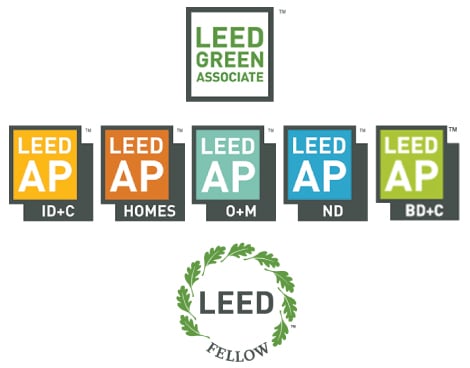No products in the cart.
LEED AP Acronym Comes with Some History & Context
Many moons ago, when LEED credentials were first established for green building professionals, there was a designation called LEED AP. The LEED AP acronym stood for LEED Accredited Professional.
Things were simple back then. If you wanted to pursue a LEED credential, you became a LEED AP.
LEED Version 3 debuted and changed the credentialing process.
In April 2009, the U.S. Green Building Council (USGBC) modified the LEED standards. They named the new version LEED 2009, or LEED Version 3. This version modified the credentialing process significantly.
Instead of just one designation, three levels were born:
- LEED Green Associate
- LEED AP with Specialty
- LEED Fellow
What happened to the pre-2009 LEED APs?
They were given many opportunities to opt into the new tiered process and update their status from LEED AP to the new LEED AP With Specialty designation.
Alternatively, some people chose not to opt into the new system and instead chose to remain a regular LEED AP, or what some would call a LEED AP Without Specialty.
How did LEED v3 impact pre-2009 LEED APs’ careers?
There was no way for LEED APs at the time to know that their credential would later be viewed as archaic and out of touch.
In fact, the USGBC stopped featuring them in their directory of accredited professionals! We wrote more about this controversy in our other LEED AP Without Specialty blog post.
What happened when LEED Version 4 launched in 2014?
LEED Version 4 replaced LEED 2009.
Given that so much had changed in the LEED standards and the green building industry in general, the original LEED APs are no longer allowed to opt into the new system as quickly and easily as before.
If they want to opt into the new version, pre-2009 LEED APs have to start at the beginning of the LEED credentialing process, with LEED Green Associate.

It’s possible to do nothing and remain a regular LEED AP for life, but since that credential is 5+ years out of date, these individuals will be recognized as inactive LEED professionals.
LEED AP vs. LEED AP Specialty
So, to summarize, LEED AP is not the same as LEED AP with Specialty.
You can identify a professional from before LEED 2009 if his or her name is followed simply by the LEED AP acronym.
You can identify a professional from after LEED 2009 (versions 3 or 4) if his or name is followed by a series of acronyms, such as LEED AP BD+C, LEED AP O+M, LEED AP ID+C, LEED AP ND, or LEED AP Homes.
What do those LEED AP acronyms mean?
These five acronyms represent the five LEED AP specialties available under LEED 2009 (and going forward under LEED Version 4).
Spelled out, these specialties are:
- LEED AP Building Design and Construction
- LEED AP Operations and Maintenance
- LEED AP Interior Design and Construction
- LEED AP Neighborhood Development
- LEED AP Homes
Nowadays, if you say that you want to become a LEED AP, you may or may not be referring to one of these advanced LEED AP specialties. Yes, I said advanced.
LEED Green Associate is the first step to earning a LEED credential.
This is the mandatory first step for everyone, regardless of occupation, education, and experience. Everyone has to pass the LEED Green Associate exam before proceeding to a LEED AP with Specialty designation.
For most people, LEED Green Associate is sufficient. If you work in the sustainability industry but maybe you don’t work on LEED projects regularly, then a LEED Green Associate accreditation is perfectly sufficient for you.
If, however, you do work on LEED projects in some regard, then you should consider advancing to the LEED AP specialty that most corresponds with your job responsibilities.
By and large, the most popular LEED AP specialties are LEED AP Building Design + Construction and LEED AP Operations and Maintenance.
At Everblue, we provide exam prep training for LEED Green Associate, LEED AP BD+C, and LEED AP O+M.
The lesson for today is this: Whether you’re brand new to LEED or want to earn the coveted LEED AP credential, you must first earn your LEED Green Associate. No matter what. Get started now!
